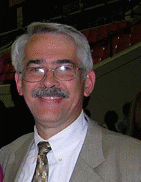08:00 | Conference Registration, Coffee, and Breakfast Pastries |
|
Joint Plenary Session: Extracellular Vesicles and Extracellular Nucleic Acids as Circulating Biomarkers |
| |
|
Session Chair: John Palma, Ph.D., Roche Molecular Systems |
| |
09:00 |  | Keynote Presentation Exosomes: From “Dust” to Multiplexed Diagnostic Biomarker
Doug Taylor, Chief Scientific Officer, Exosome Sciences Inc, United States of America
Exosomes are nano-sized vesicles released by all cell types and their protein and RNA cargo mirror the composition of their originating cells. In the case of cancer cells, the released exosomes exhibit proteins and RNA associated with the tumor and can be used as surrogates to define tumor type and stage and to predict therapeutic responses. While exosomes possess the FDA-defined features of ideal biomarkers and can be easily obtained and assessed, several obstacles have limited their clinical applications. The most critical barrier to their diagnostic application is the isolation of disease-specific exosomes and characterization their cargo. Emerging technologies will be discussed by the isolation of exosomes, associated specifically with cancers, allowing their use in diagnosis, patient stratification for therapy, monitoring therapeutic responses in real time and early identification of recurrence. These approaches target the unique properties and compositions of specific vesicle populations. The isolation of enriched pathology-specific vesicles enhances the signal to noise ratio and allows the identification of markers directly derived from the specific cell types. By correlating these circulating markers with the molecular characteristics and real-time clinical parameters, the use of circulating vesicles represents the ideal, multiplexed marker platform for clinical management. |
|
09:30 |  | Keynote Presentation Saliva-based Exosomes for Liquid Biopsies
David Wong, Felix and Mildred Yip Endowed Chair in Dentistry; Director for UCLA Center for Oral/Head & Neck Oncology Research, University of California-Los Angeles, United States of America
Constitutive activation of epithelial growth factor receptor (EGFR) is prevalent in epithelial cancers, particularly in non-small-cell lung carcinoma (NSCLC). EGFR mutation predicts sensitivity to EGFR-targeted therapy and mutation detection is mainly based on tissue biopsy, which is invasive, expensive and time-consuming. Non-invasive, real-time, point-of-care, inexpensive detection and monitoring of EGFR mutations in NSCLC patients is highly desirable. We developed a novel core technology, Electric Field-Induced Release and Measurement (EFIRM), relying on a multiplexible electrochemical sensor that can detect EGFR mutations directly from body fluids. EFIRM for EGFR mutation detection was established in vitro, and correlated with tumor size from xenografted mice. In clinical application, we demonstrated that EFIRM can detect EGFR mutations from saliva and serum of 22 NSCLC patients. And finally, a blinded test was performed on saliva from 40 NSCLC patient saliva samples. The receiver operating characteristic analysis indicated that EFIRM detected the exon 19 deletion with an area under the curve (AUC) of 0.94 and the L858R mutation with an AUC of 0.96. Our data indicate that EFIRM is effective, accurate, rapid, user-friendly, and cost effective for the detection of EGFR mutations in saliva of NSCLC patients. We termed this SAliva-Based EGFR (SABER) Mutation Detection for detection and monitoring EGFR mutations in saliva of NSCLC patients. |
|
10:00 |  | Keynote Presentation Performance of a Blood-based Assay for the Detection of EGFR Mutations in NSCLC
John Palma, Chief Medical Officer, Roche Sequencing Solutions, United States of America
|
|
10:30 |  | Keynote Presentation Comprehensive Genomic Profiling in Clinical Oncology: Overcoming the Challenges
Vincent Miller, Chief Medical Officer, Foundation Medicine, United States of America
|
|
11:00 | Coffee Break, Visit Exhibitors and Networking |
11:30 |  | Keynote Presentation Extracellular RNA in Biofluids as Biomarkers of Disease
Xandra Breakefield, Professor, Mass General Hospital (MGH)/Harvard Medical School, United States of America
Most cells in the body release extracellular RNA (exRNA) within vesicles or in association with ribonucleoprotein/lipoprotein particles. This overview talk will consider the types of RNA released, the biofluids analyzed, and modes of evaluation of the quantity and sequence of exRNAs as a index of different disease states. Examples will be provided for analysis of exRNA from serum/plasma, urine and cerebral spinal fluid of cancer patients with a focus on discovery of novel non-coding RNAs and quantitation of rare, mutant RNAs. |
|
12:00 |   | Keynote Presentation Noninvasive Cancer Genomics and Exploring Potential Clinical Applications of Circulating Tumor DNA
Nitzan Rosenfeld, Senior Group Leader, Cancer Research UK and CSO, Inivata Ltd.
Davina Gale, Head of Molecular Diagnostics, Co-Founder, Inivata, United Kingdom
Novel biomarkers are required to accurately assess tumour burden and
response in cancer. Circulating tumour DNA (ctDNA), containing
tumour-specific DNA alterations, is present in patient plasma as a
fraction of the total cell-free DNA. The study of ctDNA levels and
mutational profile could potentially inform clinical decision making, be
used to monitor tumour dynamics, assess response to treatment and
identify mutations associated with acquired drug resistance. Inivata is
a clinical cancer genomics company focused on harnessing the emerging
potential of circulating DNA analysis to improve cancer testing and
treatment. Novel applications of ctDNA are enabled by Inivata’s
technology platform which includes its proprietary enhanced TAm-Seq™
technology, to allow the detection and analysis of genomic material from
a cancer patient’s cell-free DNA collected through routinely accessible
blood samples. This non-invasive approach – a liquid biopsy – offers a
revolution in how cancer is detected, monitored and treated. |
|
12:45 | Networking Lunch, Visit the Exhibitors and Poster Viewing |
14:00 |  Technology Spotlight: Technology Spotlight:
Beckman Coulter Cytoflex Violet SSC: An alternative to FSC PMT or Fluorescence in the Detection of Extracellular Vesicles
Vasilis Toxavidis, Resource Director of BIDMC/HSCI Flow Cytometry Core, Beth Israel Deaconess Medical Center, United States of America
John Tigges, Flow Cytometry Science Center Director, Beth Israel Deaconess Medical Center, United States of America
The interest in the identification and detection of submicron particles has increased in recent years. The ability to study them has been hindered by available techniques to measure particles at sizes below 1um. Flow Cytometry has become an important tool in EV research with instrumentation being developed to identify particles at the submicron level. Instrumentation such as cytometers optimized to improve light scattering collection and image cytometers. However, most equipment designed for the detection of EVs is expensive and complex. Hardware enhancements have focused around the development of the FSC PMT. While the FSC PMT enhancements have proven to enable the flow cytometer to detect particles <200nm in size, the instrumentation is not practical for all lab settings. In this comparison study, it has been shown that the Cytoflex is compatible to the results obtained from the AstriosEQ, NanoView, and Gallios. The ability to resolve and distinguish the populations as effectively as its counterparts, has proven the Cytoflex Violet SSC to be a viable alternative to the FSC PMT to detect EVs.
|
|
Session Title: Exosomes and Microvesicles in Various Disease Classes -- Cancer, CNS, Cardiovascular Disease |
| |
|
Session Chair: Kendall Van Keuren-Jensen, Ph.D., TGEN and Johan Skog, Ph.D., Exosome Diagnostics |
| |
14:30 |  | Keynote Presentation Exosome Biomarkers: Current State and Future Directions
Johan Skog, Chief Scientific Officer, Exosome Diagnostics Inc, United States of America
|
|
15:00 | RNA Signatures Associated with Brain Injury and Disease
Kendall Van Keuren-Jensen, Professor and Deputy Director, Translational Genomics Research Institute, United States of America
One of our goals has been to examine the extracellular RNA contents in cell-free biofluids to identify markers of brain injury and disease. We have examined multiple biofluid types from patients with head trauma and neurodegenerative disease. We discuss the utility of each biofluid in reliably reflecting injury and we will discuss common and specific RNAs that are altered by injury and disease. |
15:30 | Coffee Break, Networking, Exhibit and Poster Viewing |
16:00 | Roles of Mesenchymal Stem Cell–derived Exosomal Non-coding RNAs in the Oncogenic Potential of Glioma Stem Cells and in microRNA-based Therapy for Glioblastoma
Chaya Brodie, Professor, Henry Ford Hospital, United States of America
Mesenchymal stromal cells (MSCs) are multipotent stem cells that reside in various tissues such as bone marrow, adipose, placenta and umbilical cord. MSCs are able to cross the blood brain barrier and migrate to and track glioma. Endogenous MSCs derived from bone marrow and adipose tissues have been reported to migrate to tumor sites and promote EMT and metastasis. We explored the role of exosomes derived from adipose derived MSCs and found that administration of these MSCs or their exosomes increased the self-renewal, stemness markers, mesenhycmal transformation and the migration of glioma stem cells (GSCs). In contrast, cord and placenta-derived MSCs and their secreted exosomes exerted opposite effects and their intracranial administration decreased the tumor growth of GSC-derived xenografts and prolonged animal survival. miRNA sequencing and long non-coding RNA array analyses of these exosomes revealed a set of specific miRNAs and lncRNAs that were downregulated and acted as tumor suppressors in GSCs. Some of these miRNAs were delivered to GSCs following treatments with MSC-derived exosomes and exerted a strong inhibitory effect on the growth of GSC-derived xenograft. The role of exosome-derived miRNAs in the regulation of GSC oncogenic potential, and their clinical applications in stem cell-based glioma therapeutics will be discussed. |
16:30 | Large Oncosomes as a Novel Source of Circulating DNA and miRNA in Cancer
Dolores Di Vizio, Professor, Cedars Sinai Medical Center, United States of America
Our group and others have demonstrated that cancer cells release oncogenic cargo in extracellular vesicles (EVs). Transit of EVs through tissue spaces can alter the tumor microenvironment and elicit behavioral responses by cells exposed to them, such as cell motility, invasiveness and metastatic propensity. These discoveries point to a role in tumor evolution for a conserved and finely regulated biological process that allows intercellular transfer of bioactive proteins, nucleic acids and lipids in the form of pre-assembled plasma membrane structures. Several approaches toward development of a “liquid biopsy” for cancer have been attempted. It has been known for years that both DNA and RNA can be detected in the circulation, and that circulating, cell-free (cf) DNA is more abundant in cancer patients than in controls, and can be an indicator of resistance to therapeutic regimens. Circulating DNA is also present in EVs derived from normal and tumor cells. The possibility that EVs preserve the stability of extracellular nucleic acid in the bloodstream is stimulating efforts to use EV fraction(s) in blood as a non-invasive source of personalized markers of disease aggressiveness, and as a means of following cancer progression and regression in real time. Our team recently reported that silencing of the gene encoding the cytoskeletal regulator Diaphanous related formin-3, DIAPH3, in tumor cells results in a transition to a rapid migratory phenotype characterized by dynamic membrane perturbations and increased metastatic potential. We also discovered that DIAPH3 silencing results in the export of large (1-10 µm diameter) bioactive EVs (large oncosomes) that originate from the shedding of bulky membrane protrusions from the plasma membrane. We have demonstrated that the abundance of large oncosomes in the circulation and in tissues correlate with advanced disease in mouse models and human subjects. |
17:00 | Small Volume Biofluid Analysis: Challenges and Solutions for Working with Extracellular and Exosomal RNAs
Shlomit Kenigsberg, Senior Researcher, Create Fertility Centre, Canada
Small volumes of bodily fluids are a vital source for clinical diagnostics, providing important information on tissues and organs. These fluids contain an assortment of biomarkers, including protein complexes, extracellular and vesicular RNAs, each carrying a distinct signature from the point of origin, and potentially cargo for downstream cellular processes. However, many times these samples are limited in volume and precious to get, therefor the analysis of these fluids is inherently challenging. Firstly, these fluids come in extremely small volumes, and thus, only allow for a limited number of tests. Secondly, these fluids contain a large amount of abundant proteins, such as albumin and immunoglobulins and complement factors, which can mask and contaminate the proteomic analyses. Furthermore, extracellular RNAs are not easily separated from the intra-vesicular RNAs and thus, might skew the transcriptome results. Lastly, these fluids can contain a heterogeneous population of extracellular vesicles that are difficult to parse. In this review, I will discuss the sample processing of Cerebrospinal fluid (CSF), synovial fluid, lacrimal fluid, nipple discharge (breast cancer), aspirates from cysts, cervical mucus, uterine cavity aspirates and tubal fluids, with a focus on the challenges we face with our results from follicular and, and embryo culture media, providing some solutions to study these fluids.
|
|
Session Title: Engineering of Exosomes as Delivery Vehicles |
| |
17:30 | Exosome Mediated Delivery of Therapeutic Oligonucleotides for Treatment of Neurodegenerative Disorders
Anastasia Khvorova, Professor, RNA Therapeutics Institute, University of Massachusetts Medical School, United States of America
Oligonucleotide therapeutics is a new class of drugs, the clinical utility of which has been limited by inefficient tissue distribution and cellular uptake. Through our research, we have developed a novel methodology that enables the loading of hydrophobically modified oligonucleotides (hsiRNA) into exosomes. These hsiRNAs show efficient cellular uptake in vitro as well as broad brain distribution and in vivo efficacy. Exosome-formulated oligonucleotide therapeutics might be a solution for the development of novel therapeutics for the treatment of neurodegenerative disorders. |
18:00 | Using Extracellular Vesicles to Enhance Gene Delivery Properties of a Virus Vector
Casey Maguire, Assistant Professor of Neurology, Harvard Medical School, United States of America
We have previously shown that extracellular vesicles (EVs) can enhance the in vivo gene delivery efficacy of adeno-associated virus (AAV) vectors, the first commercialized gene therapy product in the western world.
Here we will provide an overview of our hybrid EV-AAV technology and provide current data on its use as a therapeutic to treat CNS disease. |
18:30 | Networking Reception: Enjoy Premium Beers, California Wines, and Appetizers with Your Colleagues with a Beautiful View of Boston and The Charles River |
19:45 | Close of Day 1 of the Conference |










